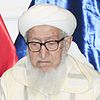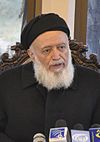President of Afghanistan
office of the head of state of Afghanistan
The President of Afghanistan was the head of state of Afghanistan. Afghanistan has only been a republic between 1973 and 1992 and from 2001 onwards. Before 1973, it was a monarchy that was governed by a variety of kings, emirs or shahs. There was a civil war from 1992 to 2001.
| President of the Islamic Republic of Afghanistan د افغانستان د اسلامي جمهوریت جمهور رئیس رئيس جمهور جمهوری اسلامی افغانستان | |
|---|---|
 | |
 | |
| Status | Office abolished |
| Residence | The Arg, Kabul, Afghanistan (former) |
| Term length | 5 years, renewable once |
| Inaugural holder | Mohammed Daoud Khan (Republic) Hamid Karzai (Islamic Republic) |
| Formation | 17 July 1973 (Republic) 7 December 2004 (Islamic Republic) |
| Final holder | Ashraf Ghani |
| Abolished | 15 August 2021 (Fall of Kabul) 6 September 2021 (official) |
| Deputy | Vice President of Afghanistan |
| Salary | 960,000 AFN per month[1] |
| Website | president |
After the 2021 Taliban offensive and the near seizure of the capital, incumbent President Ashraf Ghani fled Afghanistan to Tajikistan on 15 August 2021.[2][3] After Ghani fled the country, the Taliban occupied the Presidential Palace. The office was abolished on 6th September 2021.
Powers
The constitution of Afghanistan gave the president wide powers over military and legislative affairs. There was a weak national parliament.
List
| Name | Portrait | Lifespan | Term of office | Political party | |||
|---|---|---|---|---|---|---|---|
| Took office | Left office | Time in office | |||||
| Republic of Afghanistan (1973–1978) | |||||||
| Mohammed Daoud Khan |  | 1909–1978 | 17 July 1973 | 28 April 1978 | 4 years, 285 days | Independent (until 1976) | |
| National Revolutionary Party | |||||||
| President; Member of the Barakzai dynasty (first cousin of Mohammed Zahir Shah); Assassinated with most of his family during the Saur Revolution.[4] Shortly afterwards, the new military leaders announced that Khan was killed for refusing to surrender.[5] | |||||||
| Democratic Republic of Afghanistan (1978–1992) | |||||||
| Colonel Abdul Qadir |  | 1944–2014 | 28 April 1978 | 30 April 1978 | 2 days | People's Democratic Party (Khalq faction) | |
| Chairman of the Presidium of the Military Revolutionary Council | |||||||
| Nur Muhammad Taraki |  | 1917–1979 | 30 April 1978 | 14 September 1979 | 1 year, 137 days | People's Democratic Party (Khalq faction) | |
| Chairman of the Presidium of the Revolutionary Council; Assassinated by orders of Hafizullah Amin | |||||||
| Hafizullah Amin | 1929–1979 | 14 September 1979 | 27 December 1979 | 104 days | People's Democratic Party (Khalq faction) | ||
| Chairman of the Presidium of the Revolutionary Council; Assassinated by Soviet special forces during the Operation Storm-333[6] | |||||||
| Babrak Karmal |  | 1929–1996 | 27 December 1979 | 24 November 1986 | 6 years, 332 days | People's Democratic Party (Parcham faction) | |
| Chairman of the Presidium of the Revolutionary Council; Dismissed | |||||||
| Haji Mohammad Chamkani |  | 1947–2012 | 24 November 1986 | 30 September 1987 | 310 days | Independent | |
| Chairman of the Presidium of the Revolutionary Council; Appointed as part of the National Reconciliation process | |||||||
| Mohammad Najibullah |  | 1947–1996 | 30 September 1987 | 16 April 1992 | 4 years, 199 days | People's Democratic Party (Parcham faction) (until 1990) | |
| Homeland Party | |||||||
| President (Chairman of the Presidium of the Revolutionary Council until 30 November 1987); Resigned | |||||||
| Abdul Rahim Hatif |  | 1926–2013 | 16 April 1992 | 28 April 1992 | 12 days | Homeland Party | |
| Acting President; Deposed | |||||||
| Islamic State of Afghanistan (1992–2002) | |||||||
| Sibghatullah Mojaddedi |  | 1926–2019 | 28 April 1992 | 28 June 1992 | 61 days | National Liberation Front of Afghanistan | |
| Acting President; Resigned | |||||||
| Burhanuddin Rabbani |  | 1940–2011 | 28 June 1992 | 22 December 2001 | 9 years, 167 days | Jamiat-e Islami | |
| President; Between 1996 and 2001, the Islamic State remained the internationally recognized government, despite only controlling about 10% of Afghan territory | |||||||
| Hamid Karzai |  | born 1957 | 22 December 2001 | 13 July 2002 | 203 days | Independent | |
| Acting President | |||||||
| Islamic Emirate of Afghanistan (1996–2001) | |||||||
| Mullah Mohammed Omar | 1960–2013 | 27 September 1996 | 13 November 2001 | 5 years, 47 days | Taliban | ||
| Emir and Commander of the Faithful; The Islamic Emirate never attained widespread international recognition, despite controlling about 90% of Afghan territory; Deposed | |||||||
| Transitional Islamic State of Afghanistan (2002–2004) | |||||||
| Hamid Karzai |  | born 1957 | 13 July 2002 | 7 December 2004 | 2 years, 147 days | Independent | |
| Transitional President; Appointed at the 2002 loya jirga | |||||||
| Islamic Republic of Afghanistan (2004–2021) | |||||||
| Hamid Karzai |  | born 1957 | 7 December 2004 | 29 September 2014 | 9 years, 296 days | Independent | |
| President; First democratically elected head of state; Elected in 2004 and re-elected in 2009 | |||||||
| Ashraf Ghani |  | born 1949 | 29 September 2014 | 15 August 2021 | 6 years, 320 days | Independent | |
| President; First peaceful transition of power; Elected in 2014 and re-elected in 2019; He escaped from Afghanistan, during the Fall of Kabul[7] | |||||||
| Amrullah Saleh |  | born 1972 | 17 August 2021 | 6 September 2021 | 20 days | Independent | |
| First Vice President; Claimed the position of caretaker president based on Article 67 of the 2004 Constitution[8] | |||||||
| Islamic Emirate of Afghanistan (2021–present) | |||||||
| Mawlawi Hibatullah Akhundzada | born 1961 | 15 August 2021 | Incumbent | 2 years, 254 days | Taliban | ||
| Emir and Commander of the Faithful; The Islamic Emirate is currently not internationally recognized, despite controlling majority of Afghan territory | |||||||
References
Other websites
- Presidency of Afghanistan - The official website of the Office of the President of Afghanistan.
🔥 Top keywords: Main PageSpecial:Search0Slash (punctuation)BlackSpecial:RecentChanges4 (number)DavidSOLID (object-oriented design)Wikipedia:AboutFile:Sexual intercourse with internal ejaculation.webmHelp:ContentsHelp:IntroductionLisa Sparxxx2023 UEFA Champions League FinalColour24-hour clockAdolf Hitler UunonaBismillahir Rahmanir Raheem6 (number)T. N. SeshanFile:ASCII-Table-wide.svg20 (number)Poor Things (movie)United StatesCristiano RonaldoList of people who have walked on the MoonAli Malikov50 (number)17 (number)The Valley (2024 TV series)GrassList of mathematical symbolsList of U.S. states and territories by time zone8 (number)List of countries by areaWikipedia:Simple talkList of largest Hindu templesRama
